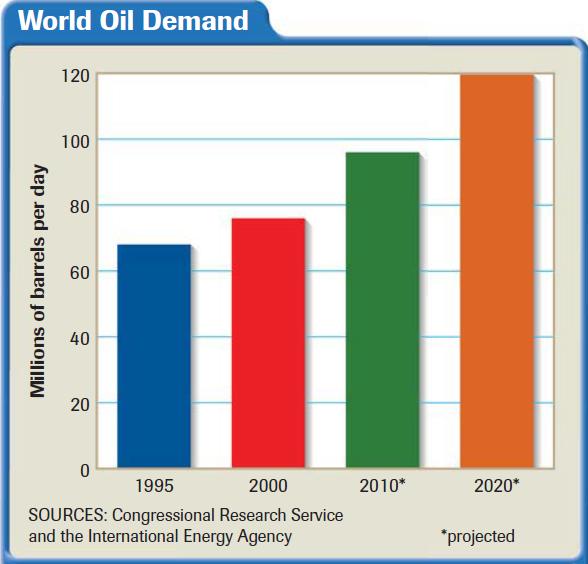Southwest Asia: Oil Wealth Fuels Change
A HUMAN PERSPECTIVE On October 2, 1995, Queen Noor of the Kingdom of Jordan gave a speech on the role of women in Southwest Asian economies. In her speech, she identified an important change in the economies of Southwest Asia: The changing environment in our region holds the promise of new opportunity for businessmen and women. Middle Eastern women are overcoming discriminatory socio-cultural constraints [limitations] that once denied them equal access to services and hindered [slowed] their participation in the economy.
Queen Noor described one of the ways in which countries in the region are using the skills of their people to change the economy. Today, money earned from the region’s most important export—oil—is helping to build a more diverse economy.
Meeting the Global Demand
At the start of the 21st century, oil fueled the world’s industries and transportation—and its economies. This “black gold” was so vital that oil became a strategic commodity, a resource so important that nations will go to war to ensure its steady supply. Southwest Asia contains much of the oil supply.
As you learned in Chapter 21, about 64 percent of the world’s proven oil deposits and 34 percent of its reserves of natural gas are found in this region. By the year 2020, exports from Southwest Asia will probably provide about 44.5 million barrels of oil per day, or about 50 percent of world demand.

These oil reserves haven’t always been of great benefit. One problem is that the world’s oil prices rise and fall unpredictably. As a result, Southwest Asian countries cannot always plan how much revenue oil will bring in. Unpredictable oil prices have also made it difficult for the region’s nations to have steady economic growth. For instance, when oil prices were low in 1996 and 1997, Southwest Asia’s economies grew slowly. Because of that experience, the nations of that region realized that they could not continue to base their economies only on oil.
Using Oil Wealth to Diversify
To promote more economic growth, the oil-rich nations of Southwest Asia face three challenges in the way that they use oil profits. First, each has to modernize its infrastructure. Second, each has to develop its agricultural, mineral, and water resources. Finally, the people of each nation have to gain access to higher education and job training.
MODERNIZING THE INFRASTRUCTURE
The region has improved its infrastructure. Saudi Arabia, for example, has built new roads in rural areas, irrigation networks, and facilities to store agricultural products. It has also built desalinization plants that remove the salt from seawater and provide water for cities and industrial use.
Other nations have constructed airports, shopping malls, and port facilities. These efforts are not always well coordinated, though. Some years ago, the UAE built four international airports to serve an area about the size of the state of Maine. Needless to say, these airports are greatly underused.
Toward the end of the 20th century, nations in the region began putting together information technology systems to serve businesses. Dubai launched a plan in 2000 called Internet City. The plan made it possible for its government to conduct business on-line.
DEVELOPING RESOURCES
To create a diversified economy, nations of the area have to develop resources besides oil. One of the greatest needs is to develop agriculture. The region’s arid conditions mean that the area is not able to produce great quantities of food. To trap much-needed water for agricultural production, governments have built dams. They have also dug deep wells to tap the water trapped in huge underground reservoirs.
Saudi Arabia can boast several economic success stories. By 1985, improvements in agriculture allowed the Saudis to completely meet the nation’s demand for dairy products, red meat, poultry, and eggs. The biggest Saudi success story, however, was wheat production.
The Saudis were determined to reduce their dependence on imported wheat. They improved water supplies so that grain production could be expanded. By 1992, they were producing more than four million tons of grain per year. This was enough to actually meet their needs and to have wheat to export. This diversification of the Saudi economy would not have happened without significant investment in infrastructure. That investment, in turn, was made possible by oil profits.
Other nations are making efforts to develop other mineral resources. Oman revived its copper industry and chromium mines. Chromium is used in steel production for jet aircraft. Expanding these industries allowed the Omani economy to reduce its dependence on oil profits.
HUMAN RESOURCES
People are a valuable resource in any nation. Southwest Asian nations are developing their human resources—the skills and talents of their people.
Many of those nations also realize that they must invest in all their people, including women. Providing education and technology training is critical. Nations are expanding the opportunities for their citizens to gain an education. For example, Kuwait has established free education for all children through the university level. For students who wish to study outside the country, the government pays the fees and provides money to cover living expenses.
Many societies in Southwest Asia have strict rules concerning women’s roles in society. Often it is difficult for women to get an education and find employment. However, the shortage of workers in the region has opened economic opportunities for women. Important economic and political changes are taking place in Southwest Asia.
As the nations work to develop their physical and human resources, opportunities for all who live there will expand. A successful economy is built on the efforts of all its people working together toward the goal of diversification.
- Southwest Asia: Population Relocation
- Southwest Asia: The Northeast
- Southwest Asia: The Eastern Mediterranean
- Southwest Asia: The Arabian Peninsula
- Southwest Asia: Human–Environment Interaction
- Southwest Asia: Climate and Vegetation
- Southwest Asia: Landforms and Resources
- Russia and the Republics: Central Asia
- Russia and the Republics: Transcaucasia